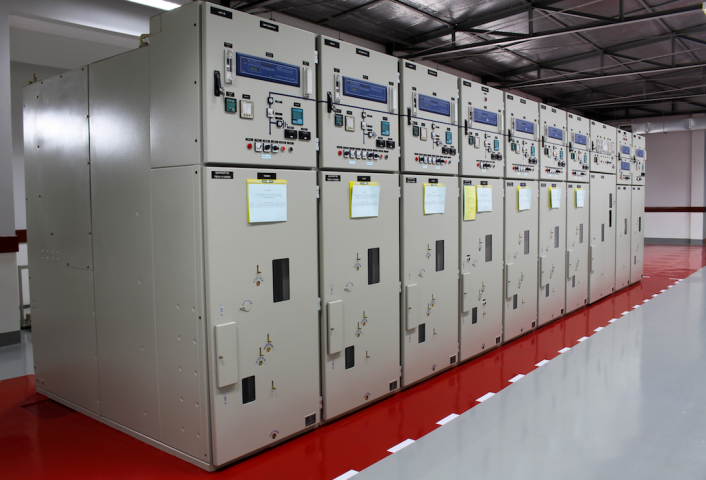TS EN / IEC 62271-1
HIGH VOLTAGE SWITCHGEAR and CONTROLGEAR
Type tests for high voltage switchgear and controlgear (Circuit Breaker, Disconnector, Load Disconnector, Fused Cell, Cell, Metal Clad, RMU, Metal Enclosure and Concrete Kiosk), rules for high voltage switching and control devices and the uniformity of verification within included tests. Type tests are carried out in independent accredited laboratories. Type tests also refer to the tests to be taken in order to obtain “LVTCERT Certificate”. Only two standards are required to determine all rules and corresponding verification methods for each type of high voltage switchgear and control devices:
Basic standard referred to as “IEC 62271-1” in special standards including High Voltage Switchgear and Controlgear (Circuit Breaker, Disconnector, Load Disconnector, Fused Cell, Cell, Metal Clad, RMU and Concrete Kiosk).
- It is the special high voltage switching and control device standard, which is also referred to as the relevant high voltage switching and control device (Circuit Breaker, Disconnector, Load Disconnector, Fused Cell, Cell, Metal Clad, RMU and Concrete Kiosk).
EN / IEC 62271-1 High Voltage Switchgear and Controlgear - Part 1 : Common specifications for alternating current switchgear and controlgear
EN / IEC 62271-1 High Voltage Switchgear and Controlgear - Part 100 : Alternating current circuit brekaers
EN / IEC 62271-1 High Voltage Switchgear and Controlgear - Part 102 : Alternating current disconnectors and earthing swithces
EN / IEC 62271-1 High Voltage Switchgear and Controlgear - Part 103 : Switches for rated voltages above 1 kV up to and including 52 kV
EN / IEC 62271-1 High Voltage Switchgear and Controlgear - Part 105 : Alternating current switch-fuse combinations for rated voltages above 1 kV up to and including 52 kV
EN / IEC 62271-1 High Voltage Switchgear and Controlgear - Part 200 : AC metal-enclosed switchgear and controlgear for rated voltages above 1 kV and up to and including 52 kV
EN / IEC 62271-1 High Voltage Switchgear and Controlgear - Part 202 : High-voltage/ low-voltage prefabricated substation
Type tests for EN / IEC 62271-1 Standard are listed below.
Dielectric Tests
Radio Interference Voltage (RIV) Test
Resistance Measurement
Continuous Current Test (Temperature Rise Test)
Short-time Withstand Current and Peak Withstand Current Tests
Verification of Protection
Tightness Tests
Electromagnetic Compatibility Test (EMC)
Additional Experiments for Auxiliary and Control Circuits
X-Ray Test for Vacuum Interrupters
1) Dielectric Tests
Unless otherwise specified by the manufacturer, dielectric tests are carried out in accordance with TS EN / IEC 60060-1 standard type tests. Type test is carried out by determining the test voltage levels according to the declaration operating voltage specified by the manufacturer from the standard.
2) Radio Interference Voltage (RIV) Test
This test is applied only to the switchgear and control device with rated voltage of 245 kV and above. Radio interference test is considered EMC emission test.
3) Resistance Measurement
Resistance measurements of the main circuit, auxiliary circuits and grounded metal parts are performed.
4) Continuous Current Test (Temperature Rise Test)
The current value suitable for the manufacturer's declaration is applied to the test sample. At the points specified by the standard, temperature values are read with the help of thermocouples. It is verified whether these values exceed the limits specified by the standard. It is checked that there is no temperature change more than 1 ̊C in the last one hour at the points where the thermal stabilisation is placed.
5) Short-time Withstand Current and Peak Withstand Current Tests
The short-time and peak strength current in accordance with the manufacturer's declaration is applied to the test sample. It is verified that it completes the test period without any deformation on the test sample.
6) Verification of Protection
With the IP code verification test, the degree of protection against foreign solid or water ingress is checked. The degree of protection against mechanical impacts is confirmed by the verification of the IK code.
7) Tightness Tests
The purpose of the leak test is to demonstrate that the absolute leak rate does not exceed the specified allowable leak rate value.
8) Electromagnetic Compatibility Test (EMC)
Emission tests, auxiliary circuits and immunity tests for control circuits, additional EMC tests for auxiliary circuits and control circuits are carried out as type tests.
9) Additional Experiments for Auxiliary and Control Circuits
Functional tests, electrical continuity of the experiment of grounded metallic sections, verification of the operating characteristics of auxiliary contacts, environmental tests, type tests are performed as dielectric tests.
10) X-Ray Test for Vacuum Interrupters
Tests of X-ray emission levels of vacuum breakers should be carried out on new breakers. The purpose of this test is to verify that the X-ray emitted from vacuum interrupters does not exceed the limits specified by the standard.

